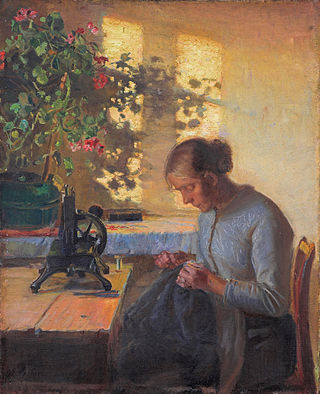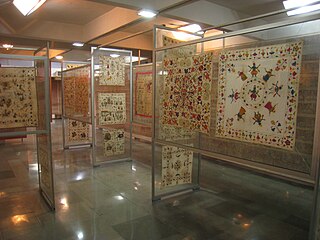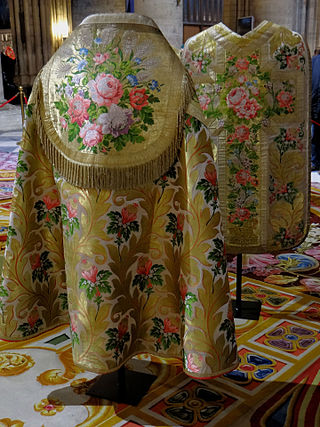Related Research Articles

Embroidery is the craft of decorating fabric or other materials using a needle to apply thread or yarn. Embroidery may also incorporate other materials such as pearls, beads, quills, and sequins. In modern days, embroidery is usually seen on caps, hats, coats, overlays, blankets, dress shirts, denim, dresses, stockings, scarfs, and golf shirts. Embroidery is available in a wide variety of thread or yarn colour. It is often used to personalize gifts or clothing items.

A loom is a device used to weave cloth and tapestry. The basic purpose of any loom is to hold the warp threads under tension to facilitate the interweaving of the weft threads. The precise shape of the loom and its mechanics may vary, but the basic function is the same.

Sewing is the craft of fastening or attaching objects using stitches made with a sewing needle and thread. Sewing is one of the oldest of the textile arts, arising in the Paleolithic era. Before the invention of spinning yarn or weaving fabric, archaeologists believe Stone Age people across Europe and Asia sewed fur and leather clothing using bone, antler or ivory sewing-needles and "thread" made of various animal body parts including sinew, catgut, and veins.

A sari is a women's garment from the Indian subcontinent, that consists of an un-stitched stretch of woven fabric arranged over the body as a robe, with one end attached to the waist, while the other end rests over one shoulder as a stole (shawl), sometimes baring a part of the midriff. It may vary from 4.1 to 8.2 metres in length, and 60 to 120 centimetres in breadth, and is form of ethnic wear in Bangladesh, India, Pakistan, Sri Lanka, and Nepal. There are various names and styles of sari manufacture and draping, the most common being the Nivi style. The sari is worn with a fitted bodice also called a choli and a petticoat called ghagra, parkar, or ul-pavadai. It remains fashionable in the Indian Subcontinent today.
Clothing in India varies with the different ethnicities, geography, climate, and cultural traditions of the people of each region of India. Historically, clothing has evolved from simple garments like kaupina, langota, achkan, lungi, sari, to rituals and dance performances. In urban areas, western clothing is common and uniformly worn by people of all social levels. India also has a great diversity in terms of weaves, fibers, colors, and the material of clothing. Sometimes, color codes are followed in clothing based on the religion and ritual concerned. The clothing in India also encompasses a wide variety of Indian embroidery, prints, handwork, embellishments, and styles of wearing clothes. A wide mix of Indian traditional clothing and western styles can be seen in India.

Darning is a sewing technique for repairing holes or worn areas in fabric or knitting using needle and thread alone. It is often done by hand, but using a sewing machine is also possible. Hand darning employs the darning stitch, a simple running stitch in which the thread is "woven" in rows along the grain of the fabric, with the stitcher reversing direction at the end of each row, and then filling in the framework thus created, as if weaving. Darning is a traditional method for repairing fabric damage or holes that do not run along a seam, and where patching is impractical or would create discomfort for the wearer, such as on the heel of a sock.

A Banarasi sari is a sari made in Varanasi, an ancient city which is also called Benares (Banaras). The saris are among the finest saris in India and are known for their gold and silver brocade or zari, fine silk and opulent embroidery. The saris are made of finely woven silk and are decorated with intricate designs, and, because of these engravings, are relatively heavy.
Balaramapuram is one of the panchayats that form the city of Thiruvananthapuram, the capital of Kerala, India. It is the most urbanized panchayat in Thiruvananthapuram.

Phulkari refers to the folk embroidery of the Punjab. Although Phulkari means floral work, the designs include not only flowers but also cover motifs and geometrical shapes. The main characteristics of Phulkari embroidery are use of darn stitch on the wrong side of coarse cotton cloth with coloured silken thread. Punjabi women create innumerable alluring and interesting designs and patterns by their skilful manipulation of the darn stitch. According to Kehal (2009), a cloth where only a few flowers are embroidered is called a Phulkari. The other types are distinct varieties. The traditional varieties of Phulkaris are large items of cloth and include Chope, Tilpatr, Neelak and Bagh. Sometimes, the Bagh is given separate categorization of its own as on other varieties of a Phulkari, parts of the cloth is visible, whereas in a Bagh, the embroidery covers the entire garment so that the base cloth is not visible. Further, in contemporary modern designs, simple and sparsely embroidered dupattas, odhinis, and shawls, made for everyday use, are referred to as phulkaris, whereas clothing items that cover the entire body, made for special and ceremonial occasions such as weddings are called baghs. The Phulkari continues to be an integral part of Punjabi weddings to the present day.

Embroidery in India includes dozens of embroidery styles that vary by region and clothing styles. Designs in Indian embroidery are formed on the basis of the texture and the design of the fabric and the stitch. The dot and the alternate dot, the circle, the square, the triangle, and permutations and combinations of these constitute the design.

Silk In India, about 97% of the raw mulberry silk is produced in the Indian states of Karnataka, Andhra Pradesh, Tamil Nadu and West Bengal. Mysore and North Bangalore, the upcoming site of a US$20 million "Silk City", contribute to a majority of silk production. Another emerging silk producer is Tamil Nadu where mulberry cultivation is concentrated in Salem, Erode and Dharmapuri districts. Hyderabad, Andhra Pradesh and Gobichettipalayam, Tamil Nadu were the first locations to have automated silk reeling units.
The manufacture of textiles is one of the oldest of human technologies. To make textiles, the first requirement is a source of fiber from which a yarn can be made, primarily by spinning. The yarn is processed by knitting or weaving, which turns yarn into cloth. The machine used for weaving is the loom. For decoration, the process of colouring yarn or the finished material is dyeing. For more information of the various steps, see textile manufacturing.

Brocade is a class of richly decorative shuttle-woven fabrics, often made in colored silks and sometimes with gold and silver threads. The name, related to the same root as the word "broccoli", comes from Italian broccato meaning "embossed cloth", originally past participle of the verb broccare "to stud, set with nails", from brocco, "small nail", from Latin broccus, "projecting, pointed".

Mekhela Sador is a traditional Assamese sarong traditionally worn by Assamese women.

Silk weaving is a manufacturing industry in Varanasi. Varanasi is known throughout India for its production of very fine silk and Banarasi saris.

Chanderi sari is a traditional sari made in Chanderi, Madhya Pradesh, India.

Gajam Anjaiah, an Indian master handloom designer, who is widely recognised in the handloom industry for his innovations and developments of Tie and Dye handloom products along with Telia Rumal technique of weaving based on Ikat tie-dye process. He received Padma Shri from Government of India under Art category in 2013. He is known for his excellence in traditional handloom design works, such as Puttapaka Sarees in Tie and dye skill, that is the traditional art of designing on paper and then transferring it on to cloth. His dedication to the Handloom Industry has kept the Indian tradition of weaving alive, brought livelihood to the weavers and gave exclusive/unique designed handloom products to the people in India.

Handloom saris are a traditional textile art of Bangladesh and India. The production of handloom saris are important for economic development in rural India.
Jadunath Supakar was an Indian artist and textile designer. He was born in 1931 in Sambalpur in the Indian state of Odisha and was known for his contributions for the popularization of handloom industry of Varanasi. He was a recipient of the Odisha Lalit Kala Academy Award and his creations have been exhibited in several countries. The Government of India awarded him the fourth highest Indian civilian honour of Padma Shri in 1985. His son, Sribhash Chandra Supakar, is also a textile designer and a national award winner.

Habaspuri is a cotton-based traditional handloom textiles of Odisha, India. Habaspuri sari is a major product of this textile. The Bhulia weavers of Chicheguda, Kalahandi district, Odisha are originally attributed for weaving of the Habaspuri fabric. For its uniqueness in weaving, design and production, it has been identified as one of the 14 Geographical Indications of Odisha. The textile has traditional patterns of the region like kumbha (temple), fish and flowers.
References
- ↑ Tilfi. "Tilfi: Luxurious, handloom only clothing from the heart of Banaras". Tilfi. Retrieved 2019-07-16.
- ↑ "A guide to traditional handlooms inspired by the riches of Banaras". Vogue India. 2019-05-30. Retrieved 2019-07-16.
- ↑ "Rooted In Tradition, Tilfi Is Giving Banarasi A Modern Twist" . Retrieved 2019-07-16.